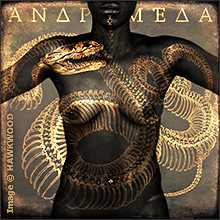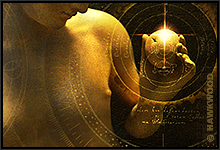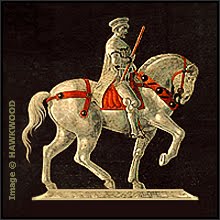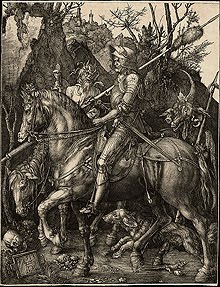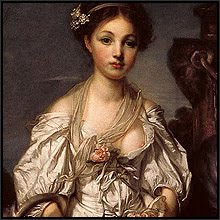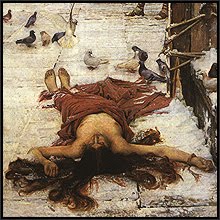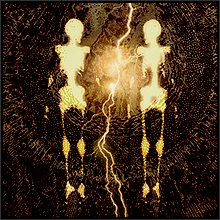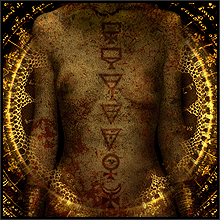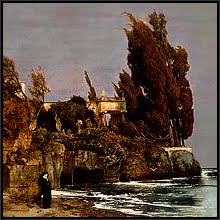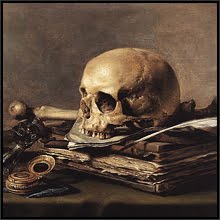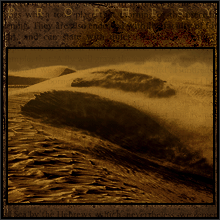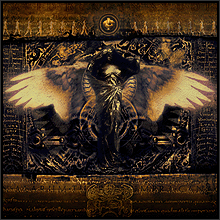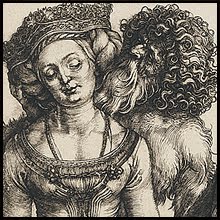This is the story of one of my pieces of cover art, and how it came into being. It is August, 1993. I receive a phone call from the art director at Puffin Books, who explains that Puffin are planning a major re-issue of their series of literary classics, and would I be interested in producing the cover art for Gaston Leroux's The Phantom of the Opera (*below) for them? Within a few days I receive contracts to paint the Phantom and *three other Gothic classics for Puffin: Bram Stoker's Dracula, Mary Shelley's Frankenstein and Edgar Allan Poe's Tales of Mystery and Terror, together with some color mock-ups from the art department of the cover designs for the new Puffin Classics series as a whole, which indicate where the title panel will be placed.

These Gothic titles are now out of copyright, which means that there are plenty of editions issued by other publishers to vie for attention in the bookshops with what Puffin will be offering. For me this is an agreeable situation, because if there are half a dozen different editions of the same book from which a potential purchaser can choose, then generally it's all down to the cover to help sway the choice that is made. At this stage I myself have no clear idea of how I am going to approach the illustration for the
Phantom, other than to be guided by Puffin's request that I feature the respective 'monster' of each Gothic on the cover.
I sift for some vision of how the Phantom – Erik in Leroux’s story – might look. The American edition which I have to hand shows only the eerily-deserted grand staircase of the Paris Opera House on the cover. It's a professionally accomplished illustration, but there's not a phantom in sight - imagined or otherwise. And the films? The 1925 silent version with Lon Chaney, Snr., once seen, remains indelibly in the mind, resonating with the authentic power of a dream, or of a nightmare. Subsequent versions tend to offer a suave and rather romantic Erik who remains discreetly masked. I make a decision to ignore all previous interpretations and go back to Leroux's original text.

The airy baroque interiors of the Paris Opera House are transformed under Leroux's pen into spaces which become dark, brooding, and strangely claustrophobic in their vastness (
above, and
below). Leroux's opera house is at the same time both the same as, yet different from, the opera house of reality. It is a world closed in upon itself, and it is only in the air of this other opera house that Erik can breathe and live out the events of his tragic life. When one begins to read the book, one begins to breathe the same air as Erik, and his presence - even on the many pages in which he does not directly appear - is tangible. I scan the pages for a description of Erik's appearance: the cadaverous face, the yellowed skin stretched taught over the bone, the lack of a nose, the inexplicable glowing lights in the dark recesses of the eyes. As with a reading of
Frankenstein, one becomes so familiar with the subsequent interpretations of others that the author's own description of the character comes almost as a shock.

I make some tentative sketches in pencil. The face described by Leroux seems so genuinely appalling that I find myself drifting towards a masked portrayal after all. I look through some pictures of stylish Venetian carnival masks. But Erik's mask is of black cloth. Not much help. Perhaps I can solve the problem by showing Erik unmasked, but keeping him as a dark figure in a corridor of shadows. I make another sketch. The result looks melodramatic - the very thing I'm trying to avoid. I decide to abandon the idea of attempting to show any atmospheric background, and zoom in on the face alone until it fills the entire cover area (my pencil sketch, below). It's only a rough sketch, but immediately I have the feeling that Erik is staring back at me. I work some more detail into the sketch and fax a copy to the art director. He offers enthusiastic encouragement for the idea.

Now begins the tracking down of reference material that might help me with the actual painting. Pictures of the Egyptian mummies in the Leiden Museum of Antiquities, and a photo of the naturally-mummified body of a priest in the Colombian Gold Museum, all become grist to the creative mill. I coat the face of my obliging son with a flour-and-water paste, then crackle-dry the resulting goo with my wife's hair dryer, studying the effect. On a canvas board I have previously applied a coating of ivory-colored oil paint with a palette knife. This ensures that the texture of the canvas will not appear too pronounced in the final reproduction, and provides me with a suitable ground on which to begin the painting. The board is about three times larger than the printed cover will be, as I know from experience that my work tends to look best in print when reduced by this ratio. But this will make the face which I am about to paint considerably larger than life-size, and my planned in-your-face approach to the Phantom becomes a shade more daunting.

I begin painting the main areas of tone with a monochromatic earth-brown oil color, and progress to the point where I must break in order to allow this first stage to dry. I prop the board against a chair in a corner of my studio. At this stage it resembles an old daguerreotype, and l'm tempted to leave the final painting with something of this look to it. As a rule, my cover paintings tend to be strongly color-themed, as this greatly enhances the impact of the printed image when it appears in the bookshop, and this seems to hold particularly true for the Gothics. There is a good reason why the original silent film version (
above) of Leroux's tale packs a greater punch than any later Technicolor version. I'm now left with time on my hands as I wait for this first stage to dry. On an impulse, and to make economic use of my own time, I begin painting
*Frankenstein (
below). From where I'm sitting I can see the first painting, and as Mary Shelley's tragic creature takes shape in front of me, Erik continues to watch me from the corner.

And so it continues, as these two feared and tragic beings gradually assume their finished form. The atmosphere in my work area becomes noticeably more oppressive. I begin to suffer from headaches, and my wife complains - with justification - of my own increasingly morose behavior. My studio becomes a no-go area for my impressionable seven year-old daughter, and I myself start to question my own wisdom in involving myself so closely with such material. Normally I prefer not to paint at night, as artificial light distorts the accuracy of colors. But now I find myself drawn to my studio over several successive evenings, working by the hard-edged light of a halogen lamp, manipulating the brush to create the blotched and mottled texture of Erik's skin. I actually enjoy the surrounding shadows. In the yellow-white halogen light I experimentally exhale smoke from my pipe onto the painting, wreathing the Phantom in a drifting cloud. The effect is wonderful, and I try to translate it into paint, making the shadow areas which surround the face less dense, until the darkest areas of the painting are the eyes themselves: twin ovals of unknowable space, in each of which a distant sun is burning, exactly as described by Leroux. The last touch is to surround these two suns with a red coronal glow, and the painting is complete.

Fifteen years later I returned to the painting to rework it digitally (
above) for a more current portfolio of my work, adding some faded blooms and a page from the score of
La Traviata. Perhaps it is an unexpected point to make, but during the creation of the original painting, as with the other Gothics, I did not intentionally set out to try and be scary. Rather, I attempted to approach these images as straight portraits, striving to keep the expressions relatively neutral. I think that readers always feel when someone is actually trying to make them scared, and the natural reaction to this tends to lead to the opposite effect. Those who have seen my 'portrait' of Erik tend to comment on a certain inexplicable gentleness in the face. It is this sensitivity of spirit, trapped as it was within a nature coupled with explosions of cruel frenzy and the despair of unappeasable loneliness, which to me represents the true horror of the Phantom.
 Artist: Hawkwood
Artist: Hawkwood
Work: The Phantom of the Opera, 1993
Medium: Oils
Location: Collection of the artist
Artist: Hawkwood
Work: Frankenstein, 1993
Medium: Oils
Location: Collection of the artist
Artist: Hawkwood
Work: The Phantom of the Opera, 2008
Medium: Scanned painted, photographic and textual elements
Location: Cyberspace
Sources:
'The Phantom of the Opera', by Gaston Leroux. Puffin Classics edition, 1994
'Frankenstein', by Mary Shelley. Puffin Classics edition, 1994
This post has been partially rewritten from my article which originally appeared in the Spring, 1995 edition of the Phantom fanzine BENEATH THE MASK. My appreciative thanks go to the founder of the British-based Phantom Appreciation Society for contacting me via the publisher to communicate her glowing response to my cover art on behalf of the Society. "All of us.."(her letter to me ended) "..have our own visions of how Erik must have looked - you have captured that vision for us." Feedback from the reading public is one thing, but to have received this reaction from such a critical audience is praise much-valued!
*My cover for this edition of the Phantom is generally available to see on the Internet, although these other versions - and the printed cover itself - tend to give my original colors a strong orange cast. For my image for this post, I have matched the colors to my original painting.
*I subsequently received commissions to produce cover art for three further Gothic titles: Victor Hugo's The Hunchback of Notre-Dame, Robert Louis Stevenson's Dr Jekyll and Mr Hyde, and Coleridge's The Rime of the Ancient Mariner. But by this time, further editorial hands were involved, and it is the Phantom, and the covers for Mary Shelley's Frankenstein and Edgar Allan Poe's Tales, which remain my own favorites, being the three titles to reach the bookshops virtually intact from my original planned sketches.
*See my post of September 13: ‘Monsters Have Light Inside’.
 Whatever it is that you seek, I hope that you may find it - or something very like it - in the year to come. And even if you do not do so, then I hope that your journey is still an interesting one.
Whatever it is that you seek, I hope that you may find it - or something very like it - in the year to come. And even if you do not do so, then I hope that your journey is still an interesting one.



